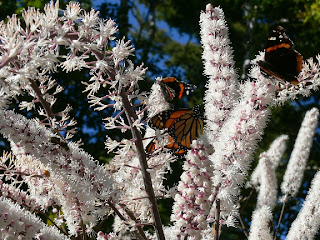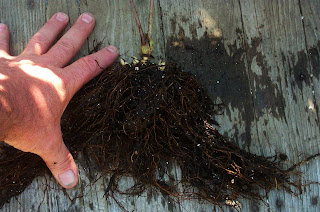
Monday, October 12, 2009
Columbus Day
A very dark morning here on the mountain. One lone star shines brightly in the eastern sky but save for a little notice of the tree tops standing out in the dark, fall mornings have become prominent for their darkness. 26 degrees so if there were any annuals left from previous frosts, yesterday was the last day to enjoy them for sure. I was surprised that the cosmos, celosia and ageratum lasted as long as they did despite earlier cold but I guess it only settled in spots and I didn't notice the difference.
This time of year I enjoy a fine perennial that had a reclassification and name change a few years back. Cimicifuga became actaea but it will take a while, maybe forever, for gardeners to make the change. It also goes by some common names such as bugbane, snakeroot, cohosh or black cohosh and has some herbal qualities that put it in demand. The uses are well publicized and if you are interested, searches are easy.
Gail collects unusual plants and she started with this one many years ago. They have architectural significance in the garden because their structure and late summer flowers add useful design elements. If you enjoy butterflies and night flying moths, that's another reason to plant them. We always planted one here, one there, then maybe a line as a garden backdrop. Three years ago, a mass planting at Maine Coastal Botanical Gardens caught my attention and I am convinced this is the way to display this plant now. Here is a picture of three years back. We just saw this same grouping this summer and the plants are massive and the bloom scapes spectacular.
This time of year I enjoy a fine perennial that had a reclassification and name change a few years back. Cimicifuga became actaea but it will take a while, maybe forever, for gardeners to make the change. It also goes by some common names such as bugbane, snakeroot, cohosh or black cohosh and has some herbal qualities that put it in demand. The uses are well publicized and if you are interested, searches are easy.
Gail collects unusual plants and she started with this one many years ago. They have architectural significance in the garden because their structure and late summer flowers add useful design elements. If you enjoy butterflies and night flying moths, that's another reason to plant them. We always planted one here, one there, then maybe a line as a garden backdrop. Three years ago, a mass planting at Maine Coastal Botanical Gardens caught my attention and I am convinced this is the way to display this plant now. Here is a picture of three years back. We just saw this same grouping this summer and the plants are massive and the bloom scapes spectacular.
 Although some try to sell this plant as a bug repellent to plant near your home, fact is it is often sweet to humans and very sweet to insects. We love to see butterflies of all types spend hours on the bottle brush flowers but Fall brings in all sorts of hornets that enjoy them too so use care when observing them or cutting some for the table.
Although some try to sell this plant as a bug repellent to plant near your home, fact is it is often sweet to humans and very sweet to insects. We love to see butterflies of all types spend hours on the bottle brush flowers but Fall brings in all sorts of hornets that enjoy them too so use care when observing them or cutting some for the table.

I like the foliage for arrangements because it can be used without long and drawn out hardening off. Atropurpurea is a bronze green color and a couple of the racemosas are green but some such as Brunette or Pink Spike (below) or Hillside Black Beauty or James Compton that are very dark and very nice. Gail has a few left for sale this year but if you are interested, give her a call as I don't make late season changes to our website.
 These plants grow well from seed although it takes a few years for the plants to mature and flower well. Now that the frost has nailed the tons of wild impatiens in the lower garden, I'll be able to see how big some of the self seeded plants grew with this summer's rains. Here's a picture of the green seed pods.
These plants grow well from seed although it takes a few years for the plants to mature and flower well. Now that the frost has nailed the tons of wild impatiens in the lower garden, I'll be able to see how big some of the self seeded plants grew with this summer's rains. Here's a picture of the green seed pods. Fall is a season when many gardeners clean up their plants and cut and discard spent foliage. Our exception is the cimificfugas because they look so pretty against the winter snow, stems and paper thin, empty seed pods waving in the breeze. I'll bet you'll agree.
Fall is a season when many gardeners clean up their plants and cut and discard spent foliage. Our exception is the cimificfugas because they look so pretty against the winter snow, stems and paper thin, empty seed pods waving in the breeze. I'll bet you'll agree.Well the sun is rising and the temperature is down to 25.1. Karl is standing here stretching and that's a signal that he wants a morning walk. I do too.
Writing from the mountain above Peacham Pond where two mourning doves sit on the platform feeder outside my office window. Their silence suggests a call for cracked corn. I will agree to the request but will only put enough out to know it will be consumed by sunset. Bears like corn too and they are still active.
George Africa
The Vermont Gardener
Vermont Flower Farm




